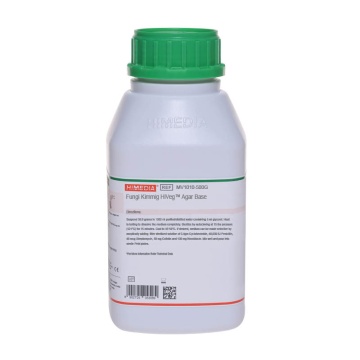 Your enquiry has been submitted
Your enquiry has been submitted
Fungi Kimmig Agar Base
Intended Use
Recommended for cultivation, isolation, identification and preservation of fungal strains.
Composition**
| Ingredients | Gms/Litre |
|---|---|
| Peptone | 9.300 |
| Tryptone | 4.300 |
| Sodium chloride | 11.400 |
| Dextrose (Glucose) | 10.000 |
| Agar | 15.000 |
| Final pH (at 25°C) | 6.5±0.2 |
**Formula adjusted, standardized to suit performance parameters
Directions
Suspend 50.0 grams in 1000 ml purified / distilled water containing 5 ml glycerol. Heat to boiling to dissolve the medium completely. Sterilize by autoclaving at 15 lbs pressure (121°C) for 15 minutes. Cool to 45-50°C. If desired, selective medium is obtained by aseptically adding filter sterilized solutions of 0.40 gm Cycloheximide, 40,000 IU Penicillin, 40 mcg Streptomycin, 80 mg Colistin and 100 mg Novobiocin in a previously cooled sterile medium. Mix well and pour in sterile Petri plates.
Principle And Interpretation
Fungi identification is usually carried out by examining the hyphae or spores formed by fungi on the medium plates. Rieth stated that Fungi Kimmig Agar Base promotes the development of growth forms, which are used as important characteristic criteria for identification (7). Fungi Kimmig Agar is formulated as described by Kimmig and Rieth for the cultivation, identification and preservation of fungal strains (6). The appearance of growth on Kimmig Agar is considered as important criteria in identification of fungal strains (7). This medium can also be used as a base for preparing selective agars.
The medium contains peptone and tryptone, which provides nitrogenous and carbonaceous nutrients, long chain amino acids andother essential growth nutrients. Dextrose is the carbohydrate source while sodium chloride maintains osmotic balance of the medium. This medium can also be used as a base for preparing selective agars. Addition of cycloheximide, according to Georg et al (2) and antibiotics like penicillin, streptomycin, according to Hantschke (3) and colistin, novobiocin etc. inhibit the growth of many gram-positive, gram-negative bacteria and also some fungi like Saccharomyces.
Type of specimen
Food samples - beverages, poultry; Dairy Samples
Specimen Collection and Handling:
For food and dairy samples, follow appropriate techniques for sample collection and processing as per guidelines (1,8,9).
After use, contaminated materials must be sterilized by autoclaving before discarding.
Warning and Precautions :
Read the label before opening the container. Wear protective gloves/protective clothing/eye protection/ face protection. Follow good microbiological lab practices while handling specimens and culture. Standard precautions as per established guidelines should be followed while handling specimens. Safety guidelines may be referred in individual safety data sheets.
Limitations :
- Some organism may show poor growth due to nutritional variation.
Performance and Evaluation
Performance of the medium is expected when used as per the direction on the label within the expiry period when stored at recommended temperature.
Quality Control
Appearance Cream to yellow homogeneous free flowing powder
Gelling Firm, comparable with 1.5% Agar gel
Colour and Clarity Medium amber coloured, clear to slightly opalescent gel forms in Petri plates
Reaction Reaction of 5.0% w/v aqueous solution at 25°C. pH: 6.5±0.2
pH 6.30-6.70
Cultural Response
Cultural characteristics observed with added antibiotics after an incubation at 25-30°C for 5-7 days.
| Organism | Growth (without antibiotics) |
|---|---|
| #Aspergillus brasiliensis ATCC 16404 (00053*) | good-luxuriant |
| Candida albicans ATCC 10231 (00054*) | good-luxuriant |
| Saccharomyces cerevisiae ATCC 9763 (00058*) | good-luxuriant |
| Trichophyton mentagrophytes ATCC 18748 | good-luxuriant |
Key: *Corresponding WDCM numbers. #Formerly known as Aspergillus niger
Storage and Shelf Life
Store between 10-30°C in a tightly closed container and the prepared medium at 20-30°C. Use before expiry date on the label. On opening, product should be properly stored dry, after tightly capping the bottle in order to prevent lump formation due to the hygroscopic nature of the product. Improper storage of the product may lead to lump formation. Store in dry ventilated area protected from extremes of temperature and sources of ignition. Seal the container tightly after use. Product performance is best if used within stated expiry period.
Disposal
User must ensure safe disposal by autoclaving and/or incineration of used or unusable preparations of this product. Follow established laboratory procedures in disposing of infectious materials and material that comes into contact with sample must be decontaminated and disposed of in accordance with current laboratory techniques (4,5).
Reference
- American Public Health Association, Standard Methods for the Examination of Dairy Products, 1978, 14th Ed., Washington D.C.
- Georg L. K., Ajello L. and Papageorge C., 1954, J. Lab. Clin. Med.; 44:422.
- Hantschcke D., 1968, Mykosen 11; 769-778.
- Isenberg, H.D. Clinical Microbiology Procedures Handbook 2nd Edition.
- Jorgensen, J.H., Pfaller, M.A., Carroll, K.C., Funke, G., Landry, M.L., Richter, S.S and Warnock., D.W. (2015) Manual of Clinical Microbiology, 11th Edition. Vol. 1.
- Kimmig J. U., Rieth H., 1953, Antimykotica in Experiment and Klinik, Arzneimittelforsch 3:267-276.
- Rieth H., 1969, Dermatophyten, Hefen und Schimmelpilze auf Kimmig-Agar. Mykosen, 12:73-74.
- Salfinger Y., and Tortorello M.L., 2015, Compendium of Methods for the Microbiological Examination of Foods, 5th Ed., American Public Health Association, Washington, D.C.
- Wehr H. M. and Frank J. H., 2004, Standard Methods for the Microbiological Examination of Dairy Products, 17th Ed., APHA Inc., Washington, D.C.
| Product Name | Fungi Kimmig Agar Base |
|---|---|
| SKU | M1010 |
| Product Type | Regular |
| Physical Form | Powder |
| Origin | Animal |
| Packaging type | HDPE |
| References | 1. Rieth H., 1969, Dermatophyten, Hefen und Schimmelpilze auf Kimmig-Agar. Mykosen, 12:73-74. |
| Customized Product Available | No |





